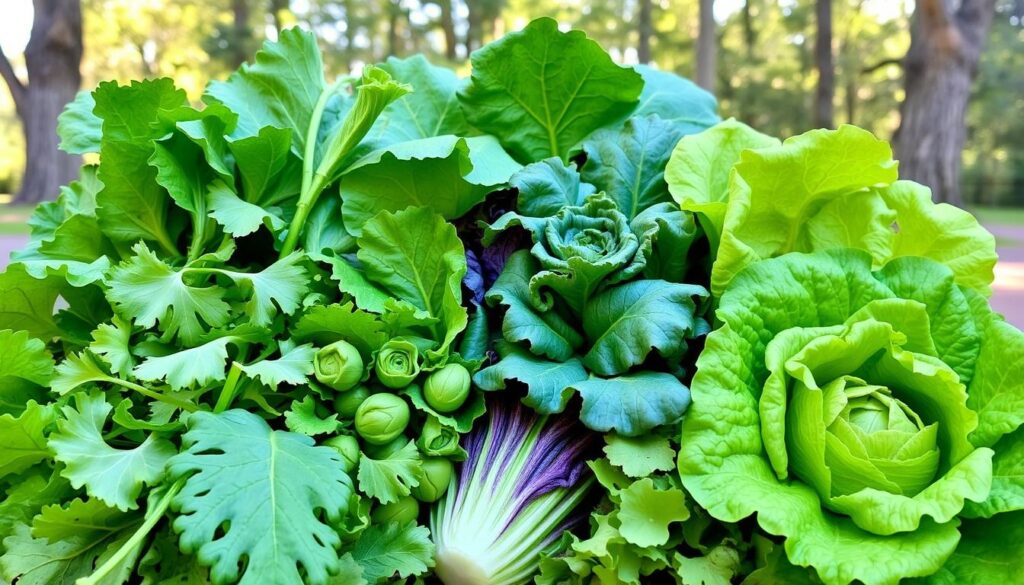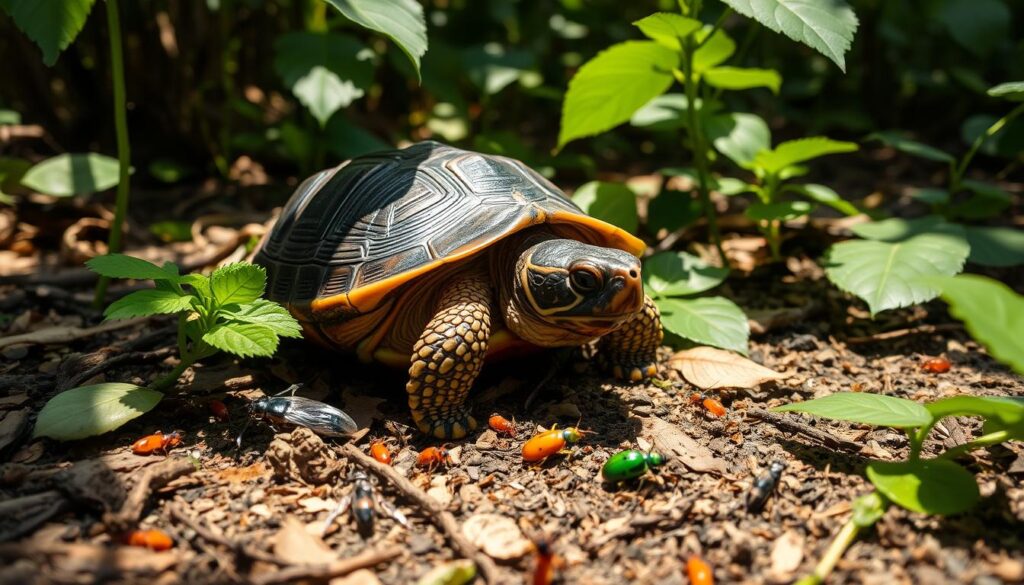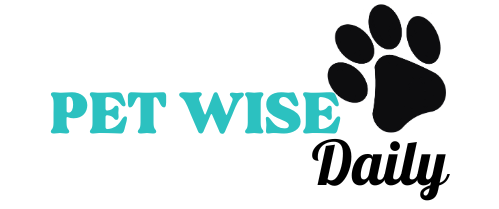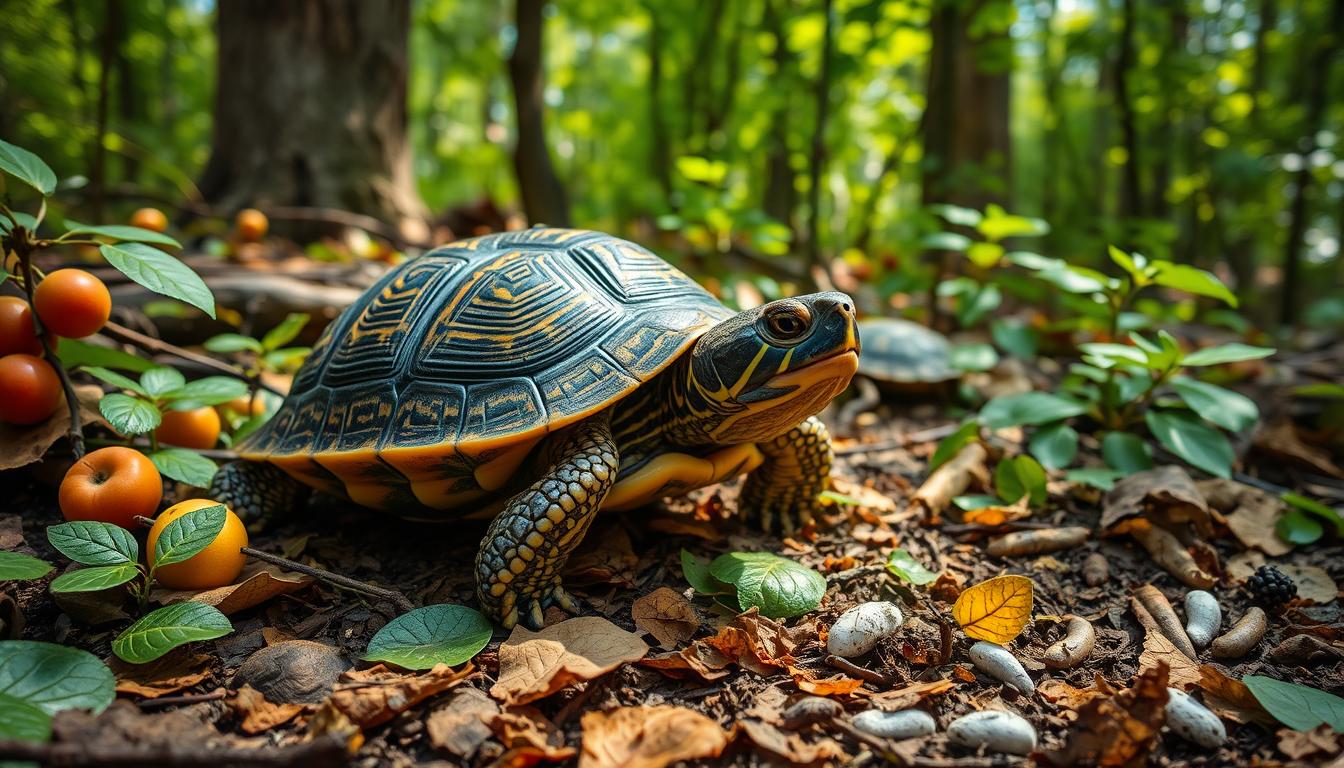Did you know that an eastern box turtle’s diet should be 50% plants and 50% animals? These reptiles eat a variety of foods based on their age. Knowing what they need is key to keeping them healthy and happy.
In this guide, we’ll look at the different types of box turtles and what they naturally eat. We’ll also cover the important nutrients they need. You’ll learn about calcium, vitamins, and the best foods for them. This will help you give your eastern box turtle a balanced diet.
Table of Contents
Understanding Box Turtle Species and Their Natural Diet
The box turtle family includes many subspecies, each with its own look and eating habits. You might know the Eastern Box Turtle, but there are others like the Gulf Coast and Ornate varieties. These turtles live in different places across North America.
Common Box Turtle Subspecies
- Eastern Box Turtle: Known for their domed shells and vibrant patterns, Eastern Box Turtles are the most widespread and commonly encountered subspecies.
- Three-Toed Box Turtle: Slightly smaller than their Eastern counterparts, Three-Toed Box Turtles can be identified by their distinctive three-toed hind limbs.
- Gulf Coast Box Turtle: Found primarily in the southeastern United States, Gulf Coast Box Turtles have a more flattened shell and tend to be more terrestrial than other subspecies.
- Ornate Box Turtle: Boasting stunning geometric patterns on their shells, Ornate Box Turtles are native to the central United States and parts of Mexico.
Wild Diet Patterns and Preferences
In the wild, box turtles eat a wide variety of foods. Young turtles mainly eat insects, small animals, and even dead animals. As they grow older, they start to eat more plants, fruits, and vegetables.
Age-Related Dietary Changes
Box turtles’ eating habits change as they get older. Young turtles, under 12 months, mostly eat meat like insects and small animals. When they become adults, they start to eat more plants, with their diet being about 50% protein, 30% non-leafy veggies, 10% leafy greens, and 10% fruits.
“Box turtles are fascinating creatures, with a remarkable ability to adapt their diets to the resources available in their local environments.”
Essential Nutrients for Box Turtle Health
Box turtles need a balanced diet full of important nutrients to stay healthy. The right turtle nutrition is key. Without it, they can get sick with things like respiratory infections and eye problems.
For box turtle vitamins, the calcium to phosphorus ratio is very important. It should be between 1.5:1 and 2:1. This helps their bones and shell grow strong. They often need extra calcium and vitamin D3 to meet their turtle mineral requirements.
- Vitamin A is vital for their eyes and immune system. Without enough, they can get sick and have breathing problems.
- Vitamin D3 helps their body use calcium and grow bones. They need UVB light to make D3.
- Calcium is essential for a strong shell and bones. Growing turtles especially need extra calcium.
Feeding them a mix of fresh fruits, veggies, and proteins helps keep them balanced. Taking them to the vet and getting advice from reptile experts is also important. This ensures they get what they need to stay healthy and live a long life.
“Proper nutrition is the foundation of a box turtle’s health and wellbeing. Ensuring they receive the right balance of essential vitamins, minerals, and nutrients is key to their long-term thriving.”
Eastern Box Turtle Diet: Core Components
Box turtles eat both plants and animals. They need a diet that’s balanced. Knowing what they should eat is key for their health and shell growth.
Plant-Based Food Sources
Dark leafy greens like kale and collard greens should be a big part of their diet. They should make up 50-70% of what they eat. Berries, apples, and melons can add 10-20% to their plant-based diet.
Animal Protein Requirements
Box turtles need a lot of animal protein. It should make up about 50% of their diet. Good protein sources include insects and small amounts of cooked lean meat.
Calcium and Mineral Balance
It’s important to keep the right balance of calcium and minerals. This helps them grow strong bones and shells. Sometimes, they need extra calcium and vitamins A and D3.
| Dietary Component | Percentage of Total Diet |
|---|---|
| Leafy Greens | 50-70% |
| Other Vegetables and Fruits | 10-20% |
| Animal Protein | 50% |
By knowing what a box turtle needs to eat, you can keep them healthy. A varied and balanced diet is important for their well-being.
Vegetable Options and Feeding Guidelines
Vegetables should be a big part of your box turtle’s diet. Good choices include collard greens, mustard greens, and dandelion greens. Kale and Swiss chard are also great. Squash, bell peppers, and carrots are other good options. Make sure to chop or shred the veggies so your turtle can eat them easily.
Don’t give your turtle iceberg lettuce or celery. They don’t have much nutrition. Instead, mix different veggies to keep your turtle’s diet balanced. Adult turtles need half plant-based and half animal-based foods for the best health.
| Vegetable | Nutritional Benefits | Preparation |
|---|---|---|
| Collard Greens | High in vitamins A, C, and K, as well as calcium and fiber | Chop or shred |
| Kale | Rich in antioxidants, vitamins, and minerals | Chop or shred |
| Bell Peppers | Packed with vitamin C and other essential nutrients | Slice or dice |
| Carrots | Excellent source of vitamin A and other carotenoids | Grate or chop |
It’s important to give your box turtle a variety of fresh, nutritious veggies. This helps keep them healthy and happy.

Fruits and Berries in Box Turtle Diet
Box turtles are omnivorous reptiles. They can eat a variety of fruits and berries. These foods add vitamins and minerals to their diet.
Safe Fruit Options
Choose fruits that are low in sugar and high in nutrients for your box turtle. Apples, berries, melons, and figs are good choices. But, avoid citrus fruits because they are too acidic.
Serving Sizes and Frequency
- Fruits should make up about 10-20% of a box turtle’s overall diet.
- Serve fruits in small portions, as they are high in natural sugars that can lead to obesity if overfed.
- Offer fruits 2-3 times per week, ensuring to remove any seeds or pits before feeding.
| Fruit | Serving Size | Feeding Frequency |
|---|---|---|
| Apples | 1-2 small slices | 2-3 times per week |
| Berries | 3-5 individual berries | 2-3 times per week |
| Melons | 1-2 small cubes | 2-3 times per week |
| Figs | 1-2 small pieces | 2-3 times per week |
Remember, give box turtle fruits in moderation. They should be part of a balanced turtle berry diet. Include protein, greens, and other nutritious foods too.
Protein Sources and Animal Matter
Box turtles need a diet rich in protein because they are omnivores. In the wild, they eat earthworms, crickets, mealworms, and sometimes lean cooked meats. Make sure any live food is gut-loaded and sprinkled with calcium powder for the best nutrition.
It’s best to avoid catching insects from the wild. They might have pesticides or other harmful substances. Protein should be about 40-50% of what an adult turtle eats. This helps them stay healthy and grow.
| Protein Source | Feeding Guidelines |
|---|---|
| Earthworms | Offer as a staple protein, gut-loaded and dusted with calcium powder |
| Crickets | Provide as a varied protein source, gut-loaded and calcium-dusted |
| Mealworms | Offer in moderation as a supplemental protein, gut-loaded and calcium-dusted |
| Cooked Lean Meats | Small amounts of cooked chicken, turkey, or beef can be provided as an occasional treat |
By giving your box turtle a variety of protein-rich foods, you help them get the nutrients they need. Always watch how much you feed to avoid overfeeding or nutritional problems.

Supplementation and Vitamin Requirements
Keeping your box turtle healthy means giving them the right nutrients. A good diet of plants, fruits, and proteins helps a lot. But sometimes, supplementation is needed to fill in the gaps.
Calcium Supplementation
Calcium is key for strong bones and a healthy shell in box turtles. To make sure they get enough, dust their food with calcium powder 2-3 times a week. You can also add a cuttlebone or calcium block to their space for extra calcium.
Vitamin A and D3 Needs
Vitamin A and D3 are vital too. Vitamin A helps with eyes, immune, and shell health. Vitamin D3 is for calcium use and absorption. Indoor turtles might need extra Vitamin A and D3 because they don’t get enough sunlight. Talk to a reptile vet to figure out the right amount for your turtle.
Good lighting, like UVB, is also important. It helps your turtle make Vitamin D3, which is key for calcium use. Make sure their home has the right light for their health.
With a balanced diet, the right supplements, and a great environment, your turtle will do well. Regular vet visits can also help you meet your turtle’s needs.
| Supplement | Frequency | Benefits |
|---|---|---|
| Calcium Powder | 2-3 times per week | Supports strong bones, healthy shell, and proper muscle function |
| Vitamin A | As needed, based on veterinarian recommendation | Supports eye health, immune function, and shell development |
| Vitamin D3 | As needed, based on veterinarian recommendation | Necessary for calcium absorption and utilization |
It’s important to give your turtle the right turtle vitamins and box turtle supplements. This ensures they get enough turtle calcium and stay healthy.
Feeding Schedule and Portion Control
Keeping a good feeding schedule and portion control is key for your box turtle’s health. Adult box turtles should eat every other day. Young ones need food daily to grow well. Baby turtles might need two meals a day because they need more nutrients.
For food amounts, aim for something about the size of your turtle’s shell. This helps them get enough food without getting too fat. Always take out any leftover food after 1-2 hours to keep things clean.
Change how often and how much you feed your turtle based on its age, size, and how active it is. Young, active turtles might need more food. Older, less active ones might need less. Watch how much your turtle eats and looks, and adjust their diet to keep them healthy.

